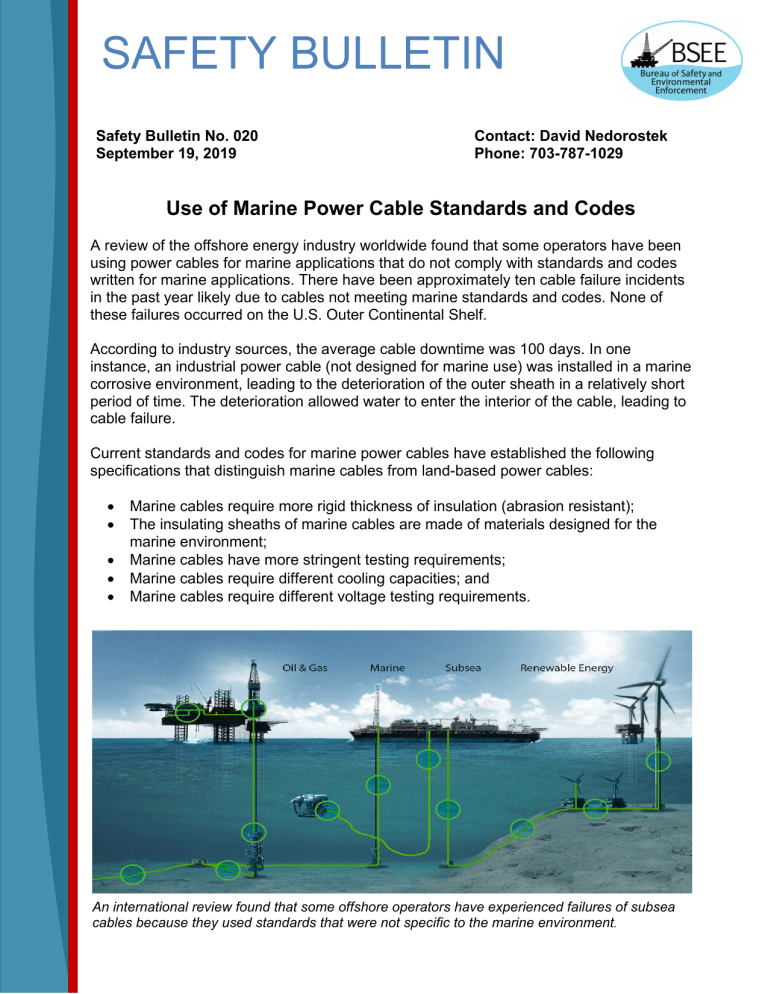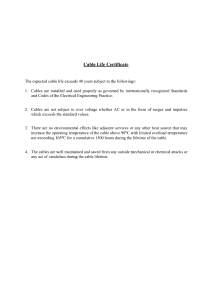
SAFETY BULLETIN Safety Bulletin No. 020 September 19, 2019 Contact: David Nedorostek Phone: 703-787-1029 Use of Marine Power Cable Standards and Codes A review of the offshore energy industry worldwide found that some operators have been using power cables for marine applications that do not comply with standards and codes written for marine applications. There have been approximately ten cable failure incidents in the past year likely due to cables not meeting marine standards and codes. None of these failures occurred on the U.S. Outer Continental Shelf. According to industry sources, the average cable downtime was 100 days. In one instance, an industrial power cable (not designed for marine use) was installed in a marine corrosive environment, leading to the deterioration of the outer sheath in a relatively short period of time. The deterioration allowed water to enter the interior of the cable, leading to cable failure. Current standards and codes for marine power cables have established the following specifications that distinguish marine cables from land-based power cables: • • • • • Marine cables require more rigid thickness of insulation (abrasion resistant); The insulating sheaths of marine cables are made of materials designed for the marine environment; Marine cables have more stringent testing requirements; Marine cables require different cooling capacities; and Marine cables require different voltage testing requirements. An international review found that some offshore operators have experienced failures of subsea cables because they used standards that were not specific to the marine environment. Marine cables are resistant to the corrosion and abrasion typically caused by ocean waves and human- or biota-related damage. Marine cables must be (1) capable of offering maximum electric transmission efficiency over longer distances, (2) low halogen and PVC-free, due to their anticipated use in confined spaces (in the event of a fire, low halogen and PVC-free cables do not produce toxic gases or smoke and are typically selfextinguishing) and (3) tinned if they are copper (to eliminate green slime/verdigris that naturally occurs when copper is exposed to salt air or saltwater). The issues raised in this Safety Bulletin could also be applicable to the emerging offshore renewable energy industry. BSEE and the Bureau of Ocean Energy Management (BOEM) are working with industry groups, such as standards development committees, on this topic. Therefore, BSEE recommends that operators consider the following: • Ensure that cable standards and codes are suitable for the operating environment in which they will be installed (e.g., subsea and/or shipboard applications); • Ensure that marine cable bends are within the limits recommended by their manufacturer, so as not to damage or overstress the cable or its insulation; • After the marine cables have been laid, ensure that electrical conductors for each cable are tested to determine insulation resistance to ground; • Evaluate aged cables for replacement in order to mitigate potential hazards; and • Review the list of standards attached to this Safety Bulletin. --BSEE-- A Safety Bulletin is a tool used by BSEE to inform the offshore oil and gas industry of the circumstances surrounding a potential safety issue. It also contains recommendations that could assist avoiding potential incidents on the Outer Continental Shelf. List of Standards to Consider with Regard to Offshore Marine Cables as of August 21, 2019 The following list of standards and codes are provided as a reference list that industry may consider when deciding on the use of and selecting marine power cables: ANSI ☐ ANSI/ICEA S-108-720: Extruded Insulation Power Cables Rated Above 46 through 500kV ☐ ANSI/NEMA WC 74/ICEA S-93-639: 5-46 kV Shielded Power Cable for use in the transmission and distribution of electric energy ☐ ANSI/ICEA S-97-682: Utility Shielded Power Cables Rated 5 through 46 kV which are used for the transmission and distribution of electrical energy. ☐ ANSI/NEMA WC 71/ ICEA S-96-659: Nonshielded Cables Rated 2001-5000 V for use in the Distribution of Electric Energy ☐ ANSI/NEMA WC 70 ICEA S -95-658: Nonshielded Power Cables Rated 2000 Volts or Less for the Distribution of Electrical Energy ☐ ANSI/ICEA T-31-610: Test Method for Conducting a Longitudinal Water Penetration Resistance Tests on Blocked Conductors CSA ☐ CSA C22.2 No. 245: Marine shipboard cable IEC ☐ IEC 63026: Submarine power cables with extruded insulation and their accessories for rated voltages from 6 kV up to 60 kV - Test methods and requirements ☐ IEC 60288: Conductors of insulated cables ☐ IEC 60092-350: General Construction and Test Methods of Power, Control and Instrumentation for Shipboard and Offshore Applications ☐ IEC 60092-353: Power cables for rated voltages 1 kV and 3 kV ☐ IEC 60092-354: Single- and three-core power cables with extruded solid insulation for rated voltages 6 kV up to 30 kV ☐ IEC 60092-359: Sheathing material for shipboard power and telecommunication cable ☐ IEC 60092-376: Cables For Control and Instrumentation Circuits 150/250 V (300 V) ☐ IEC 60183: Guidance for the selection of high-voltage A.C. cable systems IEEE ☐ IEEE 1120: Guide for the Planning, Design, Installation, and Repair of Submarine Power Cable Systems ☐ IEEE 1580: Recommended Practice for Marine Cable for Use on Shipboard and Fixed or Floating Facilities ISO ☐ ISO 29400: Ships and marine technology - Offshore wind energy –Port and marine operations UL ☐ UL 1309: Standard for Marine Shipboard Cable


